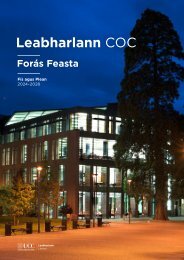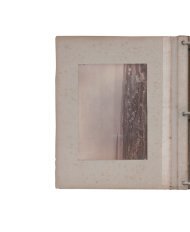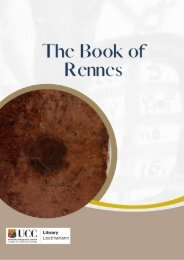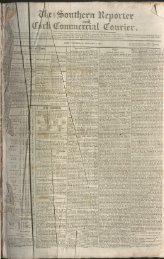Lead Toxicity in Mute Swans
LEAD TOXICITY IN MUTE SWANS Cygnus olor (Gmelin). By JOHN O'HALLORAN A thesis submitted to the National University of Ireland in candidature for the degree of Doctor of Philosophy September 1987
LEAD TOXICITY IN MUTE SWANS
Cygnus olor (Gmelin).
By
JOHN O'HALLORAN
A thesis submitted to the National University of Ireland
in candidature for the degree of Doctor of Philosophy
September 1987
Create successful ePaper yourself
Turn your PDF publications into a flip-book with our unique Google optimized e-Paper software.
for obvious reasons, the visits of the adult birds are nee ·1 b · f<br />
· Id · essart y ne<br />
This wou !11ean, tn consequence, that exposure of sub-adult birds·<br />
to t~e tdm1ttedly a~ _Yethundef<strong>in</strong>ed lead source at The Lough i~<br />
re 1 at1ve y gre .at~r an . 1s t us reflected <strong>in</strong> the blood picture.<br />
Although 1t 1s unlikely that the source of <strong>in</strong>creased lead th<br />
· L · · was e<br />
River ee - s.<strong>in</strong>ce 1t would be washed away by the swift river flow<br />
- g.rab samplmg and dredg<strong>in</strong>g has failed to confirm that the birds<br />
obta<strong>in</strong>ed lead at The ~ough. The few lead weights found there and<br />
.zero trace lead levels m .the wate: are _ . pe~plex<strong>in</strong>g and may reflect the<br />
madequac~ of t~e sampl<strong>in</strong>g techniques. Further research is obviously<br />
necessary tn this area .. Ne:ertheless, prelim<strong>in</strong>ary results from grab<br />
sampl.es at ~he Lough <strong>in</strong>dicate that the sub-littoral is silty and has<br />
very little gnt. Thus any spent lead or lead shot hav<strong>in</strong>g fallen <strong>in</strong>to the<br />
"":ater or bee.n caught ~n the vegetation would soon be picked up by<br />
blfds search<strong>in</strong>g for gnt. ·<br />
The cygnets at The Lough, as expected, had low levels <strong>in</strong> their<br />
blood (8 .28-29.80µg/100mls) compared to adult or sub-adult birds.<br />
However, cygnets contam<strong>in</strong>ated at The Lough had demonstratively<br />
higher levels than those of adults at 'country sites'. The only cygnet<br />
value lower (8.28µg/100mls) was from a very young bird -<br />
<strong>in</strong>troduced <strong>in</strong>to The Lough from Kanturk - where its parents had<br />
been killed . Note that the other cygnet <strong>in</strong> the sample had hatched at<br />
The Lough.<br />
However, blood lead levels are known to fluctuate and it has been<br />
suggested that this may be due to temporal variations <strong>in</strong> exposure.<br />
(Birkhead 1983). Indeed the degree· of exposure as <strong>in</strong>dicated by the<br />
blood picture is not now regarded as a totally reliable correlation as<br />
the elevated blood lead levels follow<strong>in</strong>g an acute exposure are not<br />
necessarily ma<strong>in</strong>ta<strong>in</strong>ed for more than seven to ten days.<br />
A good example of this problem was noted <strong>in</strong> The Lough sample.<br />
The very first bird exam<strong>in</strong>ed on 4th October 1983 had a blood lead<br />
level of 354µg/ 1 OOmls. Some three weeks later this elevated level had<br />
more than halved (31st October 1983 the blood lead level was<br />
104µg/1 OOmls). Comparable variation <strong>in</strong> blood lead levels has also<br />
been noted by Birkhead (1983). Because of the <strong>in</strong>terpretation<br />
difficulties which these fluctuations cause, it has been recommended<br />
that further assessment of the damage caused by high lead levels be<br />
obta<strong>in</strong>ed by measur<strong>in</strong>g z<strong>in</strong>c protoporphygr<strong>in</strong> <strong>in</strong> the eryth~ocyte (Bush<br />
et al 1982). This is because one of the susceptible enzymes is<br />
ferrochelatase which catalyses the conversion of protoporphr<strong>in</strong> <strong>in</strong>to<br />
haem (Lee 1981). This <strong>in</strong>hibition of protoporphyr<strong>in</strong> synthesis causes<br />
anaemia, a characteristic of lead poison<strong>in</strong>g.<br />
Although only two corpses :vere av~ilable for post:morte'!:<br />
exam<strong>in</strong>ation, they proved sufficient to illustrate the differer. .. ~<br />
between a lead poisoned bird and one with very low, presumably non-<br />
- 145 -
















